Human Resource Management: What Is It??
VerifiedAdded on 2022/08/25
|11
|2542
|25
AI Summary
Contribute Materials
Your contribution can guide someone’s learning journey. Share your
documents today.
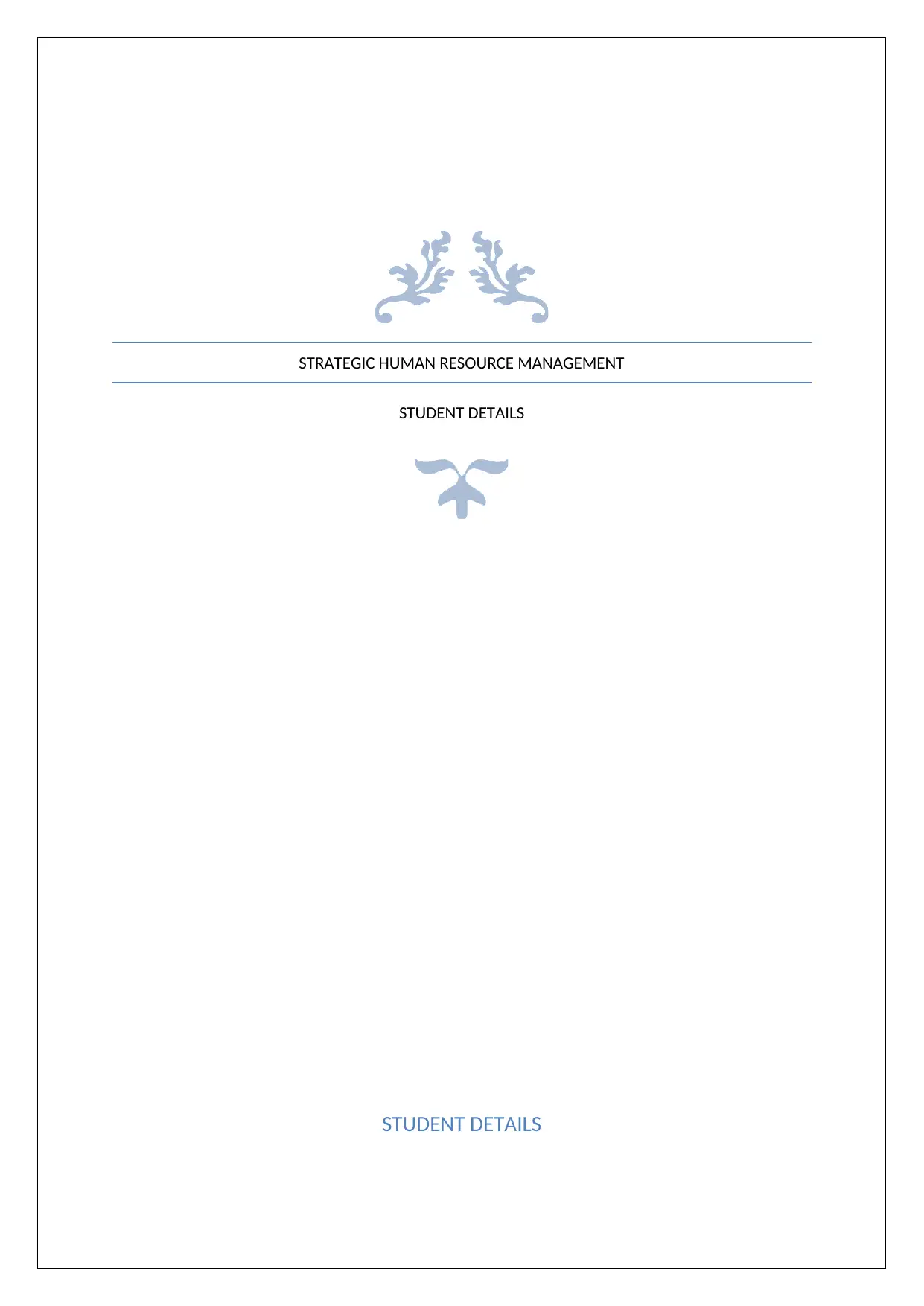
STRATEGIC HUMAN RESOURCE MANAGEMENT
STUDENT DETAILS
STUDENT DETAILS
STUDENT DETAILS
STUDENT DETAILS
Secure Best Marks with AI Grader
Need help grading? Try our AI Grader for instant feedback on your assignments.
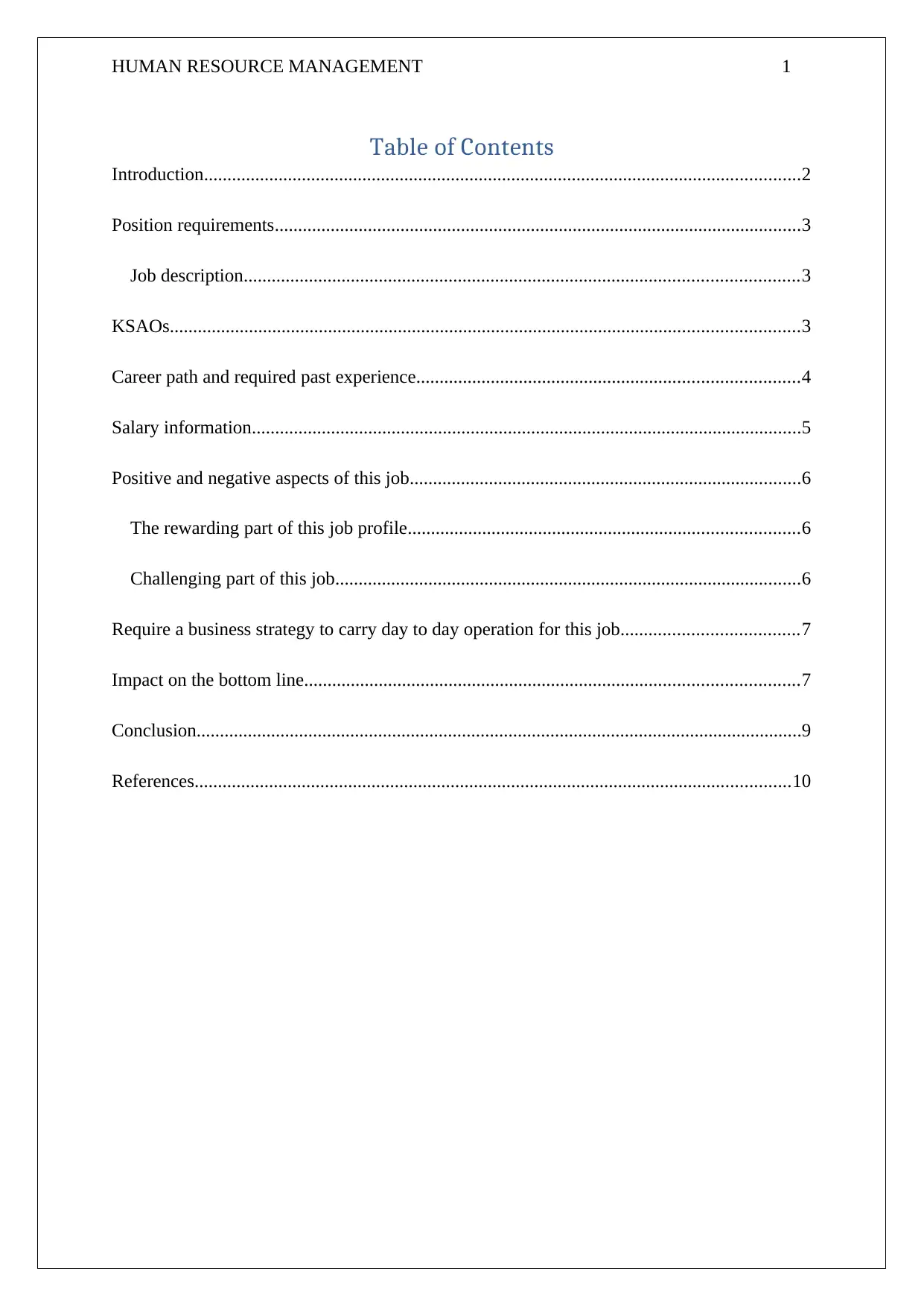
HUMAN RESOURCE MANAGEMENT 1
Table of Contents
Introduction................................................................................................................................2
Position requirements.................................................................................................................3
Job description.......................................................................................................................3
KSAOs.......................................................................................................................................3
Career path and required past experience..................................................................................4
Salary information......................................................................................................................5
Positive and negative aspects of this job....................................................................................6
The rewarding part of this job profile....................................................................................6
Challenging part of this job....................................................................................................6
Require a business strategy to carry day to day operation for this job......................................7
Impact on the bottom line..........................................................................................................7
Conclusion..................................................................................................................................9
References................................................................................................................................10
Table of Contents
Introduction................................................................................................................................2
Position requirements.................................................................................................................3
Job description.......................................................................................................................3
KSAOs.......................................................................................................................................3
Career path and required past experience..................................................................................4
Salary information......................................................................................................................5
Positive and negative aspects of this job....................................................................................6
The rewarding part of this job profile....................................................................................6
Challenging part of this job....................................................................................................6
Require a business strategy to carry day to day operation for this job......................................7
Impact on the bottom line..........................................................................................................7
Conclusion..................................................................................................................................9
References................................................................................................................................10
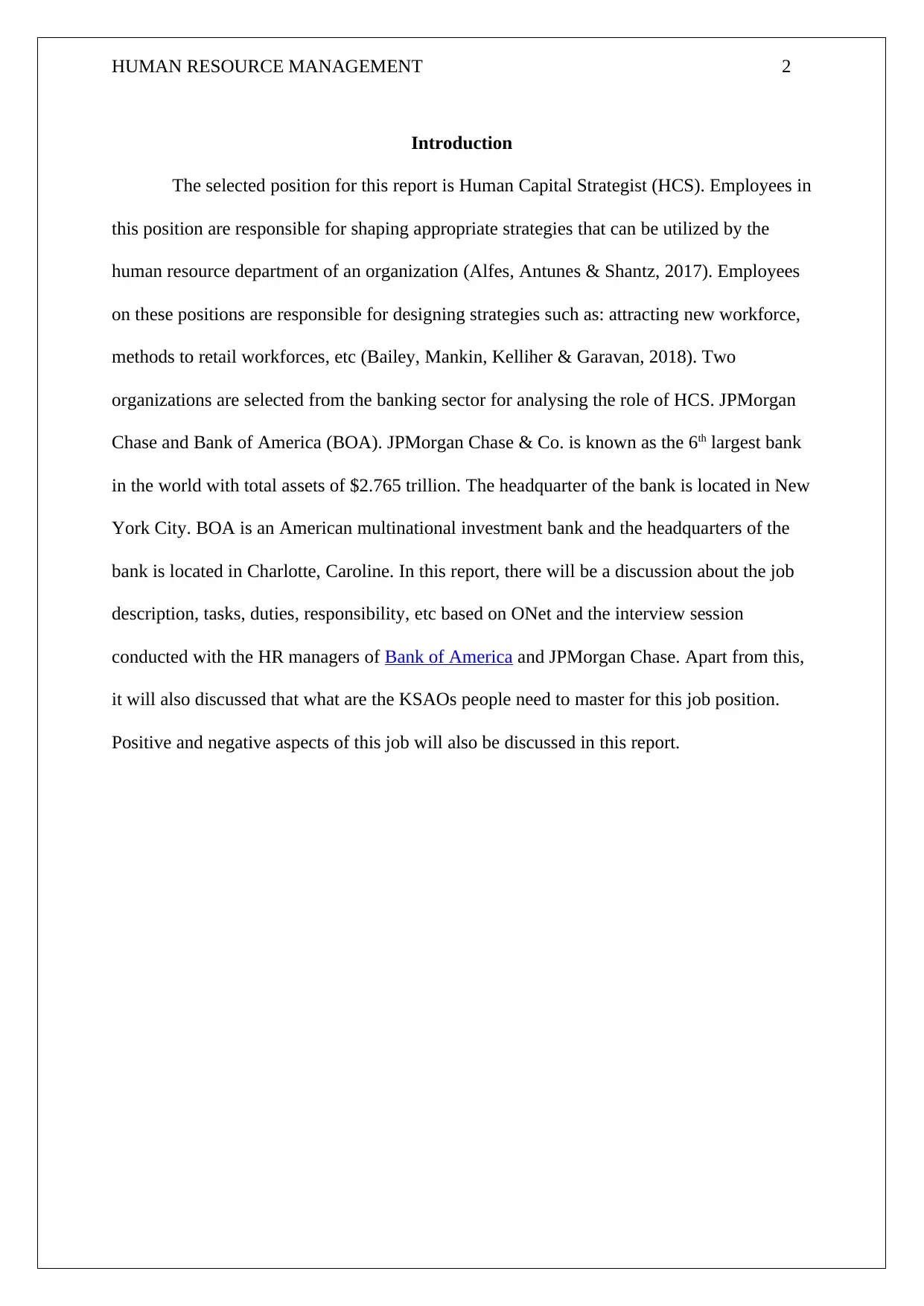
HUMAN RESOURCE MANAGEMENT 2
Introduction
The selected position for this report is Human Capital Strategist (HCS). Employees in
this position are responsible for shaping appropriate strategies that can be utilized by the
human resource department of an organization (Alfes, Antunes & Shantz, 2017). Employees
on these positions are responsible for designing strategies such as: attracting new workforce,
methods to retail workforces, etc (Bailey, Mankin, Kelliher & Garavan, 2018). Two
organizations are selected from the banking sector for analysing the role of HCS. JPMorgan
Chase and Bank of America (BOA). JPMorgan Chase & Co. is known as the 6th largest bank
in the world with total assets of $2.765 trillion. The headquarter of the bank is located in New
York City. BOA is an American multinational investment bank and the headquarters of the
bank is located in Charlotte, Caroline. In this report, there will be a discussion about the job
description, tasks, duties, responsibility, etc based on ONet and the interview session
conducted with the HR managers of Bank of America and JPMorgan Chase. Apart from this,
it will also discussed that what are the KSAOs people need to master for this job position.
Positive and negative aspects of this job will also be discussed in this report.
Introduction
The selected position for this report is Human Capital Strategist (HCS). Employees in
this position are responsible for shaping appropriate strategies that can be utilized by the
human resource department of an organization (Alfes, Antunes & Shantz, 2017). Employees
on these positions are responsible for designing strategies such as: attracting new workforce,
methods to retail workforces, etc (Bailey, Mankin, Kelliher & Garavan, 2018). Two
organizations are selected from the banking sector for analysing the role of HCS. JPMorgan
Chase and Bank of America (BOA). JPMorgan Chase & Co. is known as the 6th largest bank
in the world with total assets of $2.765 trillion. The headquarter of the bank is located in New
York City. BOA is an American multinational investment bank and the headquarters of the
bank is located in Charlotte, Caroline. In this report, there will be a discussion about the job
description, tasks, duties, responsibility, etc based on ONet and the interview session
conducted with the HR managers of Bank of America and JPMorgan Chase. Apart from this,
it will also discussed that what are the KSAOs people need to master for this job position.
Positive and negative aspects of this job will also be discussed in this report.
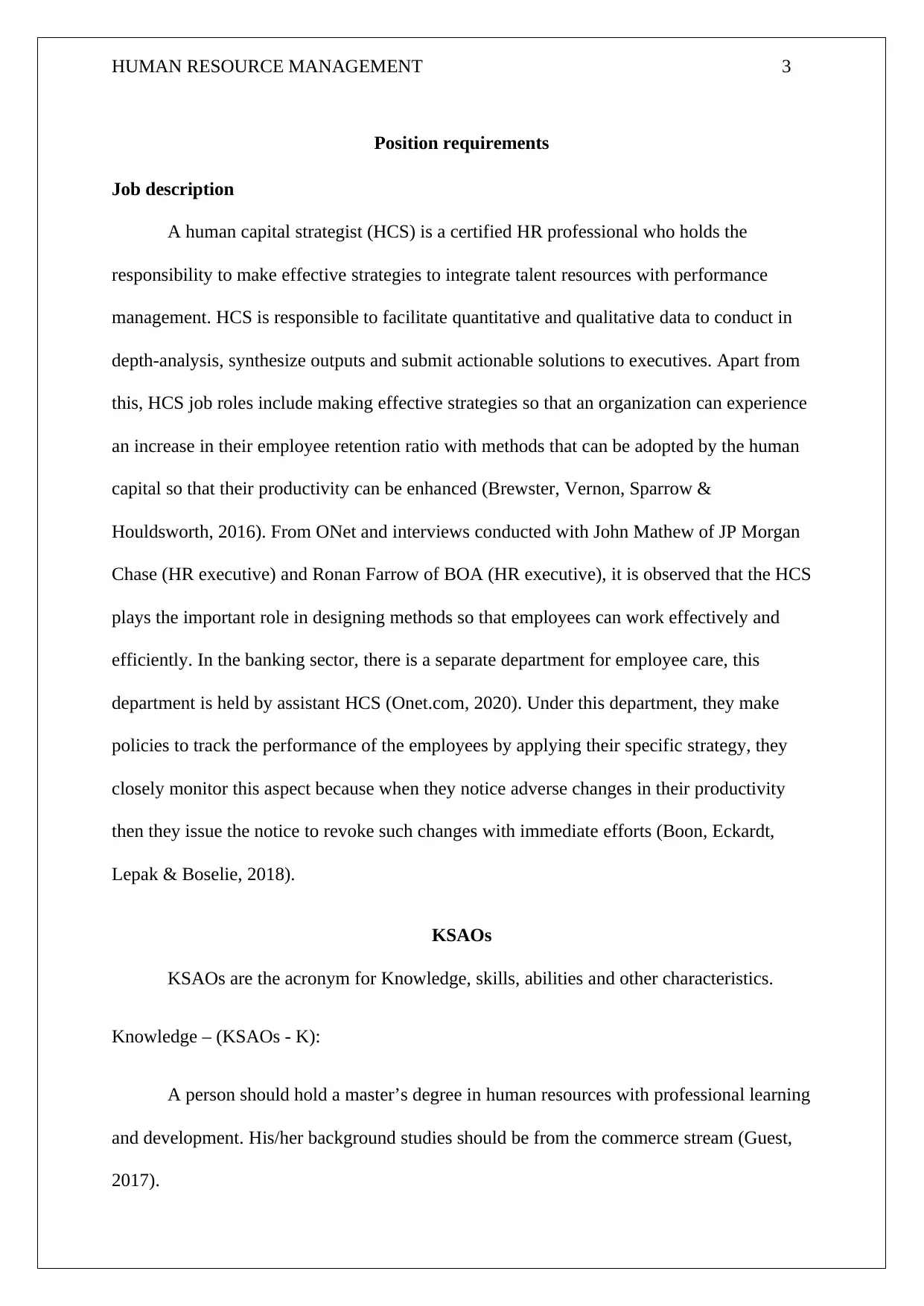
HUMAN RESOURCE MANAGEMENT 3
Position requirements
Job description
A human capital strategist (HCS) is a certified HR professional who holds the
responsibility to make effective strategies to integrate talent resources with performance
management. HCS is responsible to facilitate quantitative and qualitative data to conduct in
depth-analysis, synthesize outputs and submit actionable solutions to executives. Apart from
this, HCS job roles include making effective strategies so that an organization can experience
an increase in their employee retention ratio with methods that can be adopted by the human
capital so that their productivity can be enhanced (Brewster, Vernon, Sparrow &
Houldsworth, 2016). From ONet and interviews conducted with John Mathew of JP Morgan
Chase (HR executive) and Ronan Farrow of BOA (HR executive), it is observed that the HCS
plays the important role in designing methods so that employees can work effectively and
efficiently. In the banking sector, there is a separate department for employee care, this
department is held by assistant HCS (Onet.com, 2020). Under this department, they make
policies to track the performance of the employees by applying their specific strategy, they
closely monitor this aspect because when they notice adverse changes in their productivity
then they issue the notice to revoke such changes with immediate efforts (Boon, Eckardt,
Lepak & Boselie, 2018).
KSAOs
KSAOs are the acronym for Knowledge, skills, abilities and other characteristics.
Knowledge – (KSAOs - K):
A person should hold a master’s degree in human resources with professional learning
and development. His/her background studies should be from the commerce stream (Guest,
2017).
Position requirements
Job description
A human capital strategist (HCS) is a certified HR professional who holds the
responsibility to make effective strategies to integrate talent resources with performance
management. HCS is responsible to facilitate quantitative and qualitative data to conduct in
depth-analysis, synthesize outputs and submit actionable solutions to executives. Apart from
this, HCS job roles include making effective strategies so that an organization can experience
an increase in their employee retention ratio with methods that can be adopted by the human
capital so that their productivity can be enhanced (Brewster, Vernon, Sparrow &
Houldsworth, 2016). From ONet and interviews conducted with John Mathew of JP Morgan
Chase (HR executive) and Ronan Farrow of BOA (HR executive), it is observed that the HCS
plays the important role in designing methods so that employees can work effectively and
efficiently. In the banking sector, there is a separate department for employee care, this
department is held by assistant HCS (Onet.com, 2020). Under this department, they make
policies to track the performance of the employees by applying their specific strategy, they
closely monitor this aspect because when they notice adverse changes in their productivity
then they issue the notice to revoke such changes with immediate efforts (Boon, Eckardt,
Lepak & Boselie, 2018).
KSAOs
KSAOs are the acronym for Knowledge, skills, abilities and other characteristics.
Knowledge – (KSAOs - K):
A person should hold a master’s degree in human resources with professional learning
and development. His/her background studies should be from the commerce stream (Guest,
2017).
Secure Best Marks with AI Grader
Need help grading? Try our AI Grader for instant feedback on your assignments.
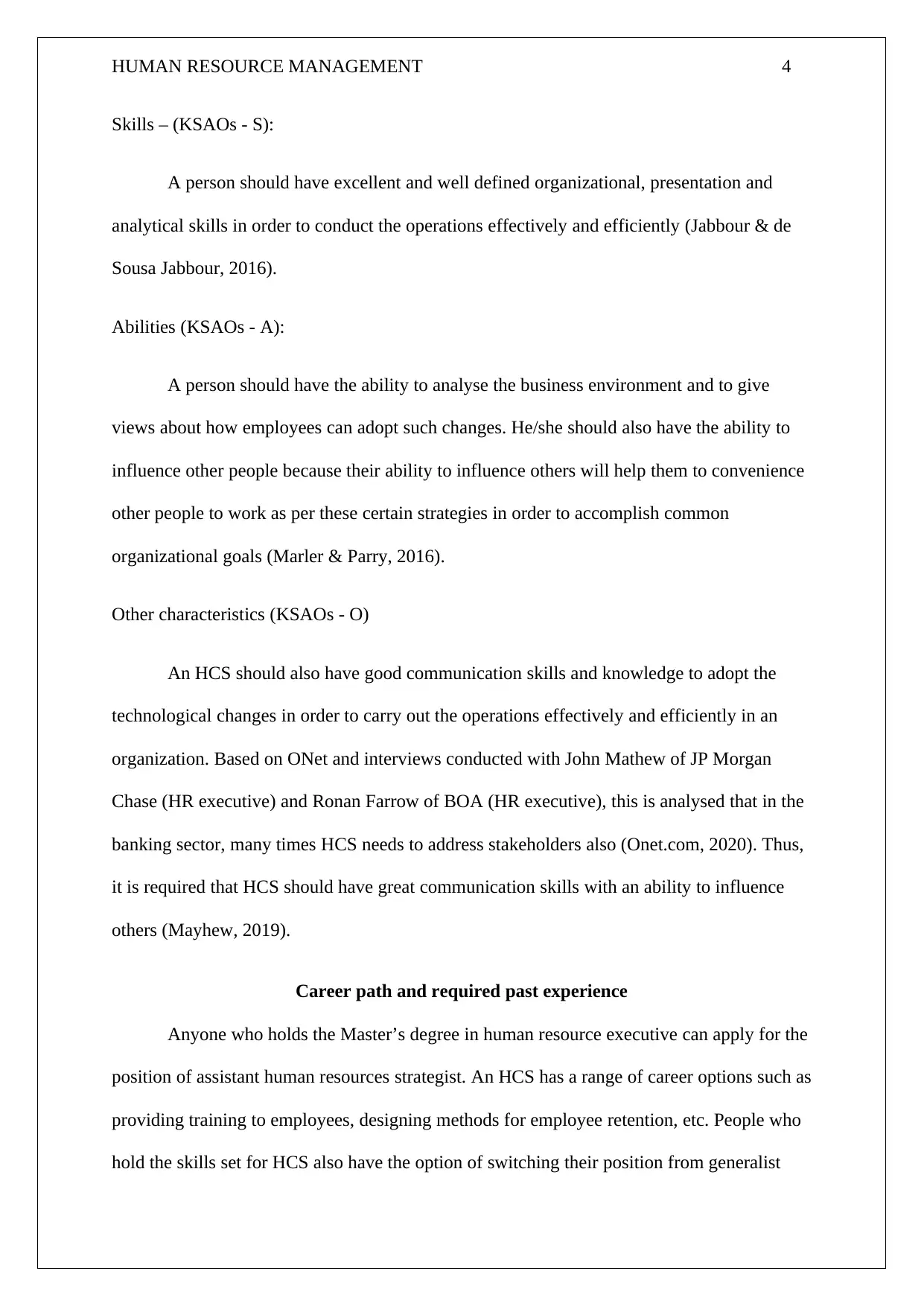
HUMAN RESOURCE MANAGEMENT 4
Skills – (KSAOs - S):
A person should have excellent and well defined organizational, presentation and
analytical skills in order to conduct the operations effectively and efficiently (Jabbour & de
Sousa Jabbour, 2016).
Abilities (KSAOs - A):
A person should have the ability to analyse the business environment and to give
views about how employees can adopt such changes. He/she should also have the ability to
influence other people because their ability to influence others will help them to convenience
other people to work as per these certain strategies in order to accomplish common
organizational goals (Marler & Parry, 2016).
Other characteristics (KSAOs - O)
An HCS should also have good communication skills and knowledge to adopt the
technological changes in order to carry out the operations effectively and efficiently in an
organization. Based on ONet and interviews conducted with John Mathew of JP Morgan
Chase (HR executive) and Ronan Farrow of BOA (HR executive), this is analysed that in the
banking sector, many times HCS needs to address stakeholders also (Onet.com, 2020). Thus,
it is required that HCS should have great communication skills with an ability to influence
others (Mayhew, 2019).
Career path and required past experience
Anyone who holds the Master’s degree in human resource executive can apply for the
position of assistant human resources strategist. An HCS has a range of career options such as
providing training to employees, designing methods for employee retention, etc. People who
hold the skills set for HCS also have the option of switching their position from generalist
Skills – (KSAOs - S):
A person should have excellent and well defined organizational, presentation and
analytical skills in order to conduct the operations effectively and efficiently (Jabbour & de
Sousa Jabbour, 2016).
Abilities (KSAOs - A):
A person should have the ability to analyse the business environment and to give
views about how employees can adopt such changes. He/she should also have the ability to
influence other people because their ability to influence others will help them to convenience
other people to work as per these certain strategies in order to accomplish common
organizational goals (Marler & Parry, 2016).
Other characteristics (KSAOs - O)
An HCS should also have good communication skills and knowledge to adopt the
technological changes in order to carry out the operations effectively and efficiently in an
organization. Based on ONet and interviews conducted with John Mathew of JP Morgan
Chase (HR executive) and Ronan Farrow of BOA (HR executive), this is analysed that in the
banking sector, many times HCS needs to address stakeholders also (Onet.com, 2020). Thus,
it is required that HCS should have great communication skills with an ability to influence
others (Mayhew, 2019).
Career path and required past experience
Anyone who holds the Master’s degree in human resource executive can apply for the
position of assistant human resources strategist. An HCS has a range of career options such as
providing training to employees, designing methods for employee retention, etc. People who
hold the skills set for HCS also have the option of switching their position from generalist
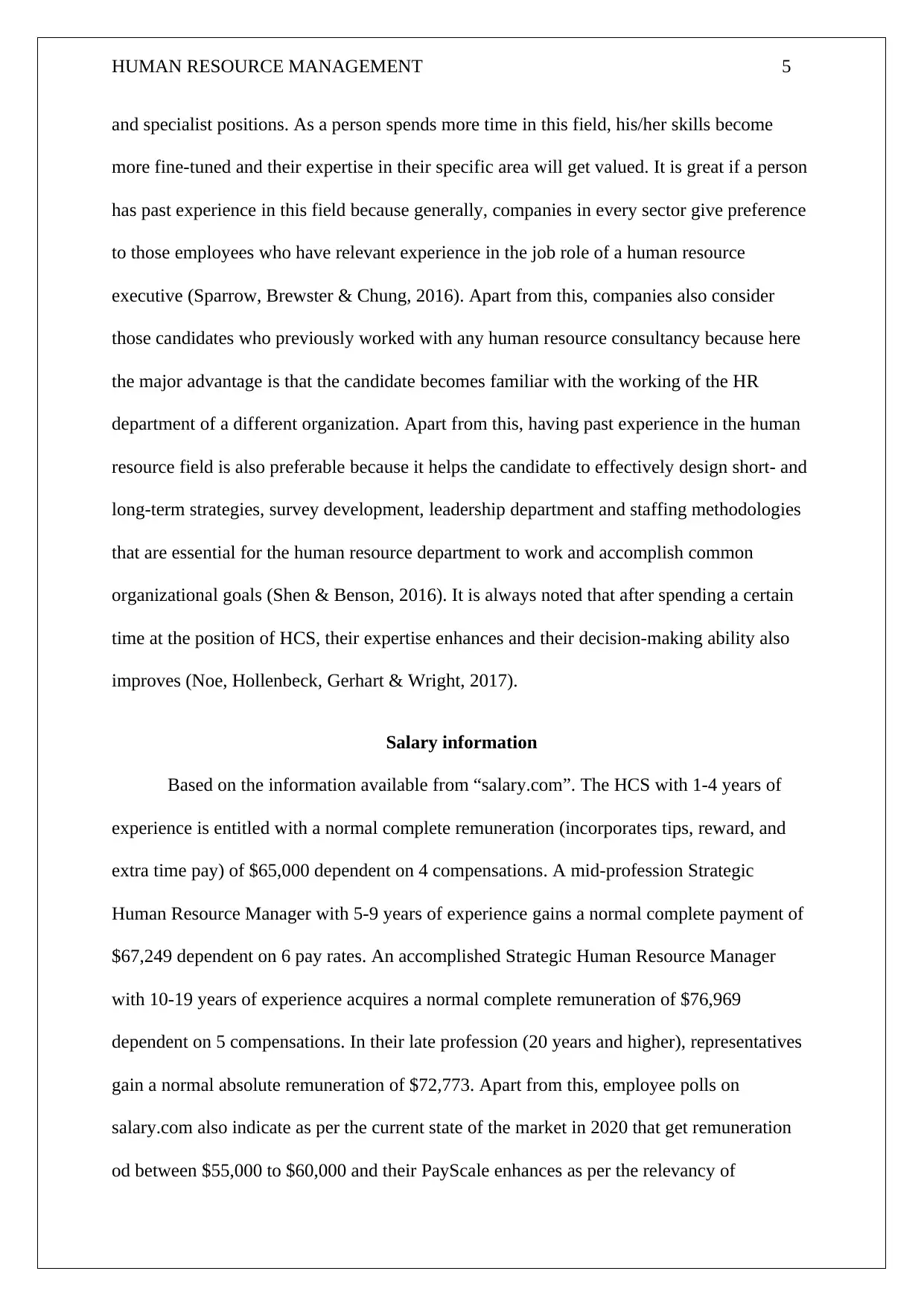
HUMAN RESOURCE MANAGEMENT 5
and specialist positions. As a person spends more time in this field, his/her skills become
more fine-tuned and their expertise in their specific area will get valued. It is great if a person
has past experience in this field because generally, companies in every sector give preference
to those employees who have relevant experience in the job role of a human resource
executive (Sparrow, Brewster & Chung, 2016). Apart from this, companies also consider
those candidates who previously worked with any human resource consultancy because here
the major advantage is that the candidate becomes familiar with the working of the HR
department of a different organization. Apart from this, having past experience in the human
resource field is also preferable because it helps the candidate to effectively design short- and
long-term strategies, survey development, leadership department and staffing methodologies
that are essential for the human resource department to work and accomplish common
organizational goals (Shen & Benson, 2016). It is always noted that after spending a certain
time at the position of HCS, their expertise enhances and their decision-making ability also
improves (Noe, Hollenbeck, Gerhart & Wright, 2017).
Salary information
Based on the information available from “salary.com”. The HCS with 1-4 years of
experience is entitled with a normal complete remuneration (incorporates tips, reward, and
extra time pay) of $65,000 dependent on 4 compensations. A mid-profession Strategic
Human Resource Manager with 5-9 years of experience gains a normal complete payment of
$67,249 dependent on 6 pay rates. An accomplished Strategic Human Resource Manager
with 10-19 years of experience acquires a normal complete remuneration of $76,969
dependent on 5 compensations. In their late profession (20 years and higher), representatives
gain a normal absolute remuneration of $72,773. Apart from this, employee polls on
salary.com also indicate as per the current state of the market in 2020 that get remuneration
od between $55,000 to $60,000 and their PayScale enhances as per the relevancy of
and specialist positions. As a person spends more time in this field, his/her skills become
more fine-tuned and their expertise in their specific area will get valued. It is great if a person
has past experience in this field because generally, companies in every sector give preference
to those employees who have relevant experience in the job role of a human resource
executive (Sparrow, Brewster & Chung, 2016). Apart from this, companies also consider
those candidates who previously worked with any human resource consultancy because here
the major advantage is that the candidate becomes familiar with the working of the HR
department of a different organization. Apart from this, having past experience in the human
resource field is also preferable because it helps the candidate to effectively design short- and
long-term strategies, survey development, leadership department and staffing methodologies
that are essential for the human resource department to work and accomplish common
organizational goals (Shen & Benson, 2016). It is always noted that after spending a certain
time at the position of HCS, their expertise enhances and their decision-making ability also
improves (Noe, Hollenbeck, Gerhart & Wright, 2017).
Salary information
Based on the information available from “salary.com”. The HCS with 1-4 years of
experience is entitled with a normal complete remuneration (incorporates tips, reward, and
extra time pay) of $65,000 dependent on 4 compensations. A mid-profession Strategic
Human Resource Manager with 5-9 years of experience gains a normal complete payment of
$67,249 dependent on 6 pay rates. An accomplished Strategic Human Resource Manager
with 10-19 years of experience acquires a normal complete remuneration of $76,969
dependent on 5 compensations. In their late profession (20 years and higher), representatives
gain a normal absolute remuneration of $72,773. Apart from this, employee polls on
salary.com also indicate as per the current state of the market in 2020 that get remuneration
od between $55,000 to $60,000 and their PayScale enhances as per the relevancy of
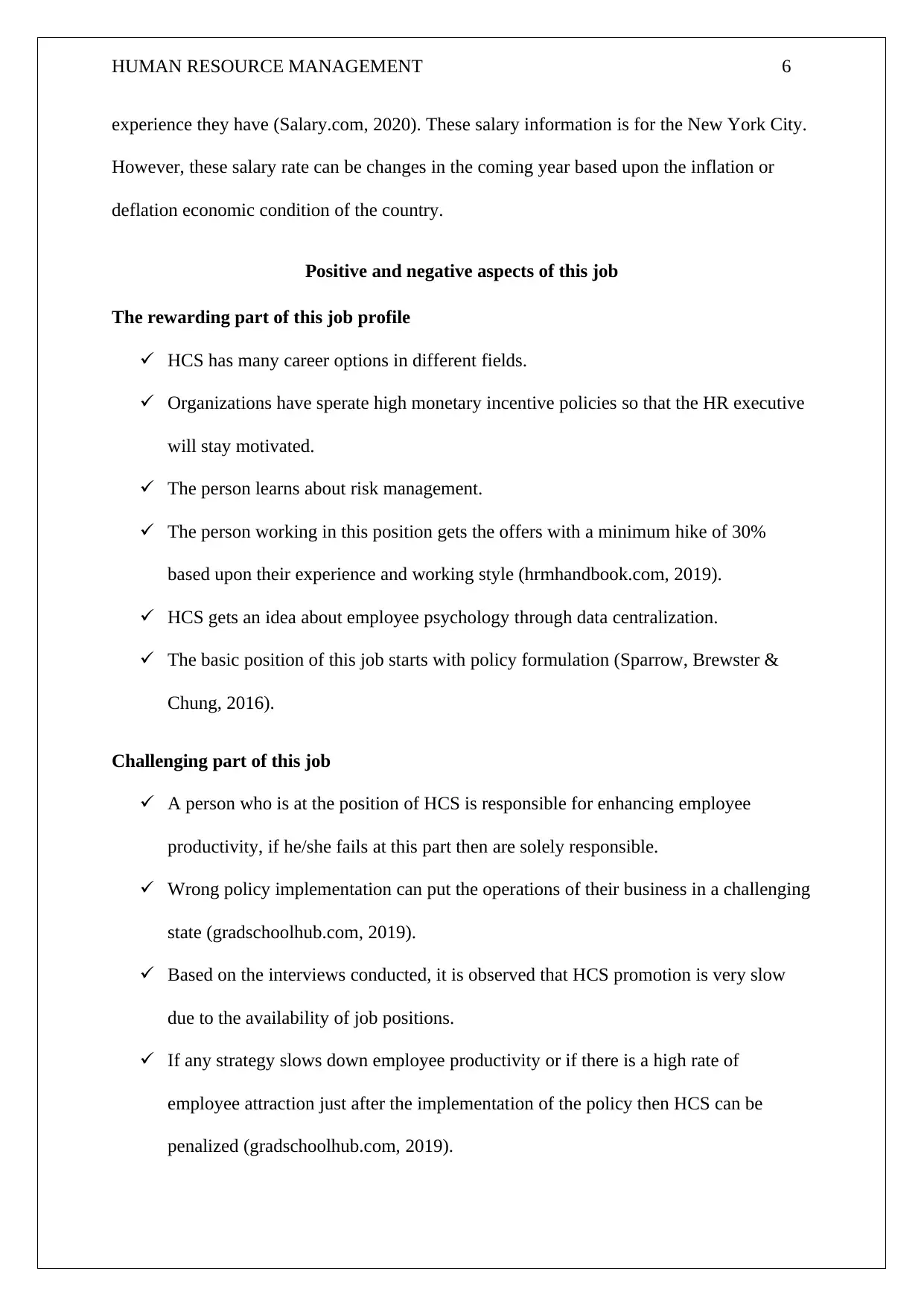
HUMAN RESOURCE MANAGEMENT 6
experience they have (Salary.com, 2020). These salary information is for the New York City.
However, these salary rate can be changes in the coming year based upon the inflation or
deflation economic condition of the country.
Positive and negative aspects of this job
The rewarding part of this job profile
HCS has many career options in different fields.
Organizations have sperate high monetary incentive policies so that the HR executive
will stay motivated.
The person learns about risk management.
The person working in this position gets the offers with a minimum hike of 30%
based upon their experience and working style (hrmhandbook.com, 2019).
HCS gets an idea about employee psychology through data centralization.
The basic position of this job starts with policy formulation (Sparrow, Brewster &
Chung, 2016).
Challenging part of this job
A person who is at the position of HCS is responsible for enhancing employee
productivity, if he/she fails at this part then are solely responsible.
Wrong policy implementation can put the operations of their business in a challenging
state (gradschoolhub.com, 2019).
Based on the interviews conducted, it is observed that HCS promotion is very slow
due to the availability of job positions.
If any strategy slows down employee productivity or if there is a high rate of
employee attraction just after the implementation of the policy then HCS can be
penalized (gradschoolhub.com, 2019).
experience they have (Salary.com, 2020). These salary information is for the New York City.
However, these salary rate can be changes in the coming year based upon the inflation or
deflation economic condition of the country.
Positive and negative aspects of this job
The rewarding part of this job profile
HCS has many career options in different fields.
Organizations have sperate high monetary incentive policies so that the HR executive
will stay motivated.
The person learns about risk management.
The person working in this position gets the offers with a minimum hike of 30%
based upon their experience and working style (hrmhandbook.com, 2019).
HCS gets an idea about employee psychology through data centralization.
The basic position of this job starts with policy formulation (Sparrow, Brewster &
Chung, 2016).
Challenging part of this job
A person who is at the position of HCS is responsible for enhancing employee
productivity, if he/she fails at this part then are solely responsible.
Wrong policy implementation can put the operations of their business in a challenging
state (gradschoolhub.com, 2019).
Based on the interviews conducted, it is observed that HCS promotion is very slow
due to the availability of job positions.
If any strategy slows down employee productivity or if there is a high rate of
employee attraction just after the implementation of the policy then HCS can be
penalized (gradschoolhub.com, 2019).
Paraphrase This Document
Need a fresh take? Get an instant paraphrase of this document with our AI Paraphraser
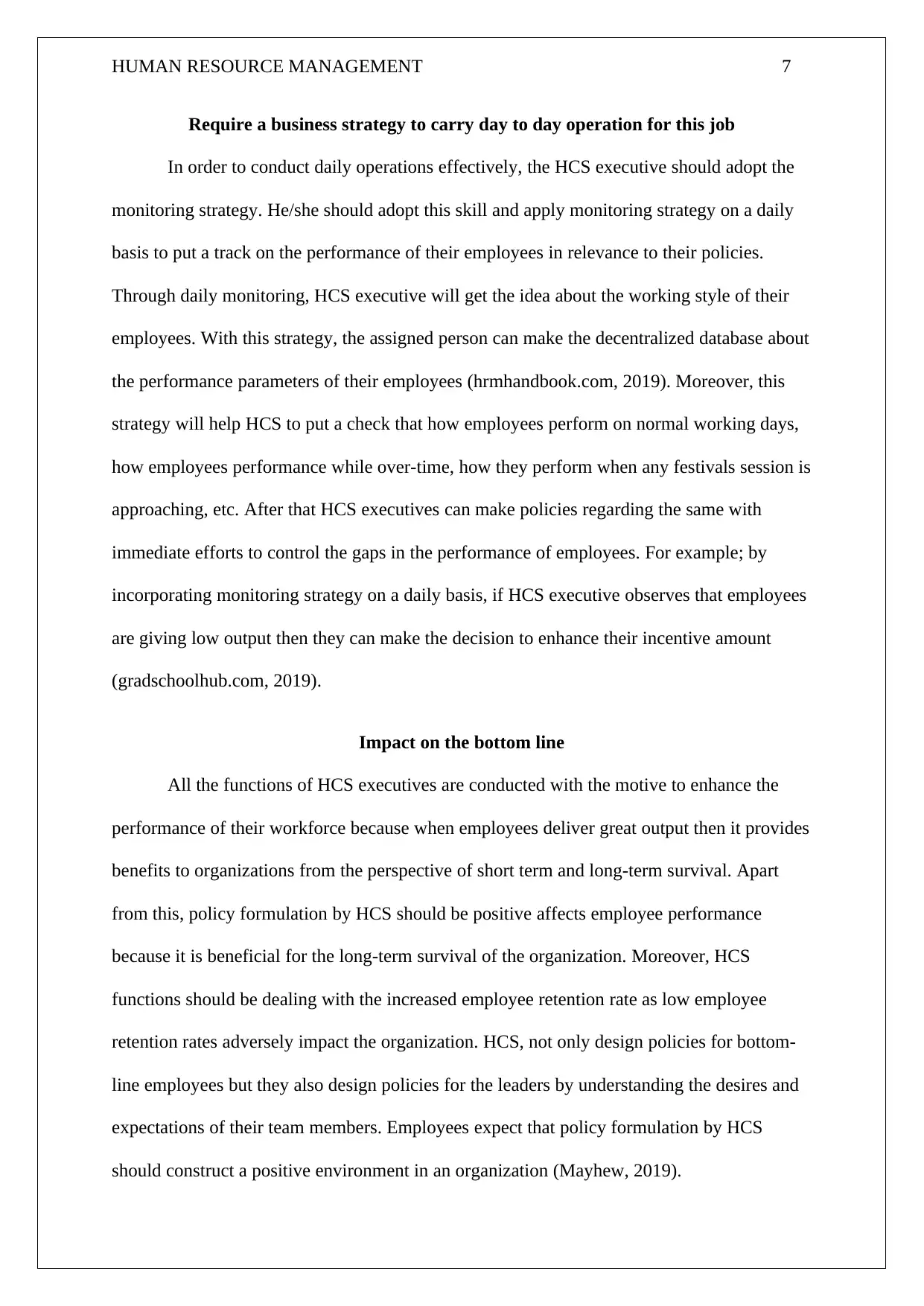
HUMAN RESOURCE MANAGEMENT 7
Require a business strategy to carry day to day operation for this job
In order to conduct daily operations effectively, the HCS executive should adopt the
monitoring strategy. He/she should adopt this skill and apply monitoring strategy on a daily
basis to put a track on the performance of their employees in relevance to their policies.
Through daily monitoring, HCS executive will get the idea about the working style of their
employees. With this strategy, the assigned person can make the decentralized database about
the performance parameters of their employees (hrmhandbook.com, 2019). Moreover, this
strategy will help HCS to put a check that how employees perform on normal working days,
how employees performance while over-time, how they perform when any festivals session is
approaching, etc. After that HCS executives can make policies regarding the same with
immediate efforts to control the gaps in the performance of employees. For example; by
incorporating monitoring strategy on a daily basis, if HCS executive observes that employees
are giving low output then they can make the decision to enhance their incentive amount
(gradschoolhub.com, 2019).
Impact on the bottom line
All the functions of HCS executives are conducted with the motive to enhance the
performance of their workforce because when employees deliver great output then it provides
benefits to organizations from the perspective of short term and long-term survival. Apart
from this, policy formulation by HCS should be positive affects employee performance
because it is beneficial for the long-term survival of the organization. Moreover, HCS
functions should be dealing with the increased employee retention rate as low employee
retention rates adversely impact the organization. HCS, not only design policies for bottom-
line employees but they also design policies for the leaders by understanding the desires and
expectations of their team members. Employees expect that policy formulation by HCS
should construct a positive environment in an organization (Mayhew, 2019).
Require a business strategy to carry day to day operation for this job
In order to conduct daily operations effectively, the HCS executive should adopt the
monitoring strategy. He/she should adopt this skill and apply monitoring strategy on a daily
basis to put a track on the performance of their employees in relevance to their policies.
Through daily monitoring, HCS executive will get the idea about the working style of their
employees. With this strategy, the assigned person can make the decentralized database about
the performance parameters of their employees (hrmhandbook.com, 2019). Moreover, this
strategy will help HCS to put a check that how employees perform on normal working days,
how employees performance while over-time, how they perform when any festivals session is
approaching, etc. After that HCS executives can make policies regarding the same with
immediate efforts to control the gaps in the performance of employees. For example; by
incorporating monitoring strategy on a daily basis, if HCS executive observes that employees
are giving low output then they can make the decision to enhance their incentive amount
(gradschoolhub.com, 2019).
Impact on the bottom line
All the functions of HCS executives are conducted with the motive to enhance the
performance of their workforce because when employees deliver great output then it provides
benefits to organizations from the perspective of short term and long-term survival. Apart
from this, policy formulation by HCS should be positive affects employee performance
because it is beneficial for the long-term survival of the organization. Moreover, HCS
functions should be dealing with the increased employee retention rate as low employee
retention rates adversely impact the organization. HCS, not only design policies for bottom-
line employees but they also design policies for the leaders by understanding the desires and
expectations of their team members. Employees expect that policy formulation by HCS
should construct a positive environment in an organization (Mayhew, 2019).
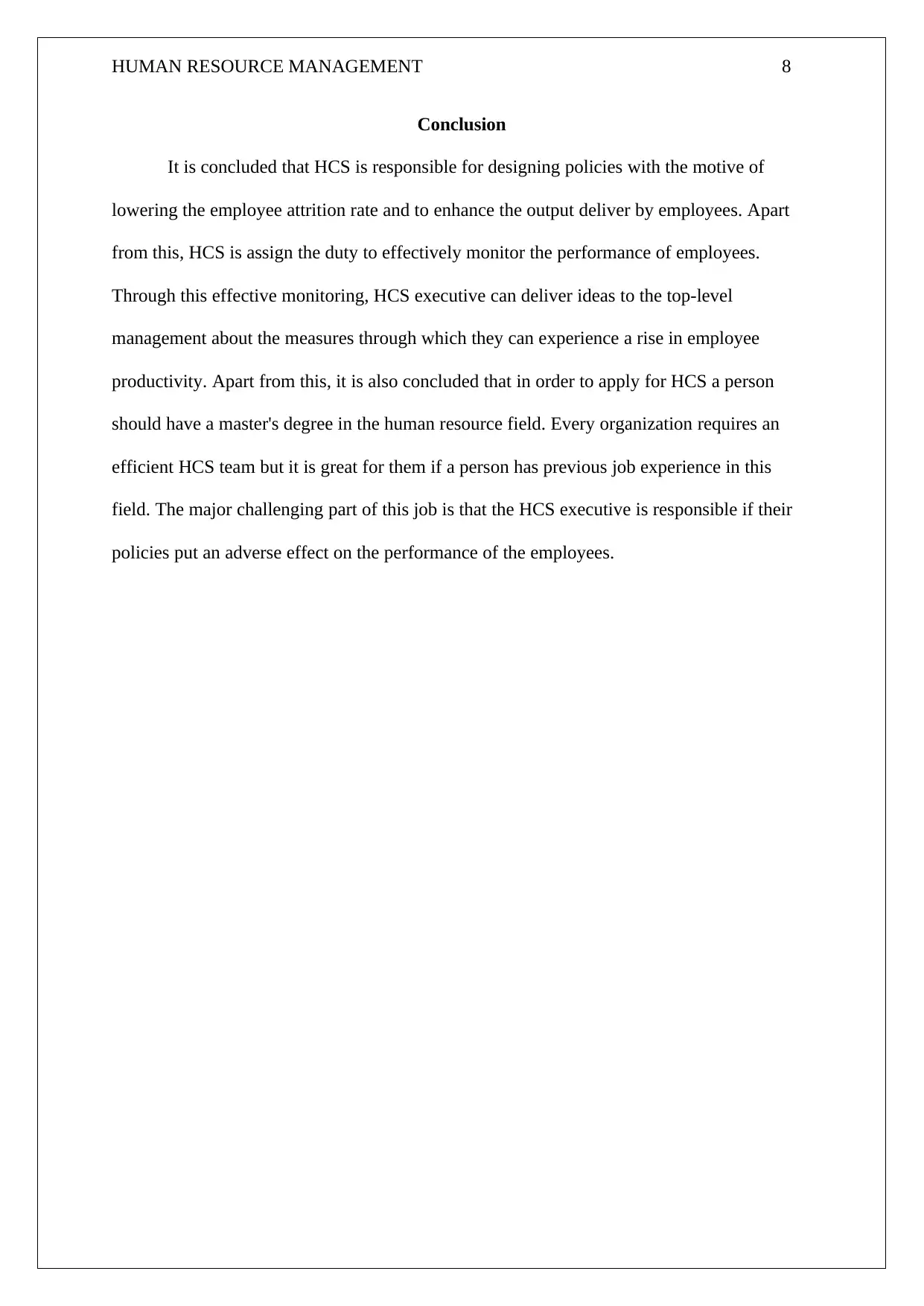
HUMAN RESOURCE MANAGEMENT 8
Conclusion
It is concluded that HCS is responsible for designing policies with the motive of
lowering the employee attrition rate and to enhance the output deliver by employees. Apart
from this, HCS is assign the duty to effectively monitor the performance of employees.
Through this effective monitoring, HCS executive can deliver ideas to the top-level
management about the measures through which they can experience a rise in employee
productivity. Apart from this, it is also concluded that in order to apply for HCS a person
should have a master's degree in the human resource field. Every organization requires an
efficient HCS team but it is great for them if a person has previous job experience in this
field. The major challenging part of this job is that the HCS executive is responsible if their
policies put an adverse effect on the performance of the employees.
Conclusion
It is concluded that HCS is responsible for designing policies with the motive of
lowering the employee attrition rate and to enhance the output deliver by employees. Apart
from this, HCS is assign the duty to effectively monitor the performance of employees.
Through this effective monitoring, HCS executive can deliver ideas to the top-level
management about the measures through which they can experience a rise in employee
productivity. Apart from this, it is also concluded that in order to apply for HCS a person
should have a master's degree in the human resource field. Every organization requires an
efficient HCS team but it is great for them if a person has previous job experience in this
field. The major challenging part of this job is that the HCS executive is responsible if their
policies put an adverse effect on the performance of the employees.
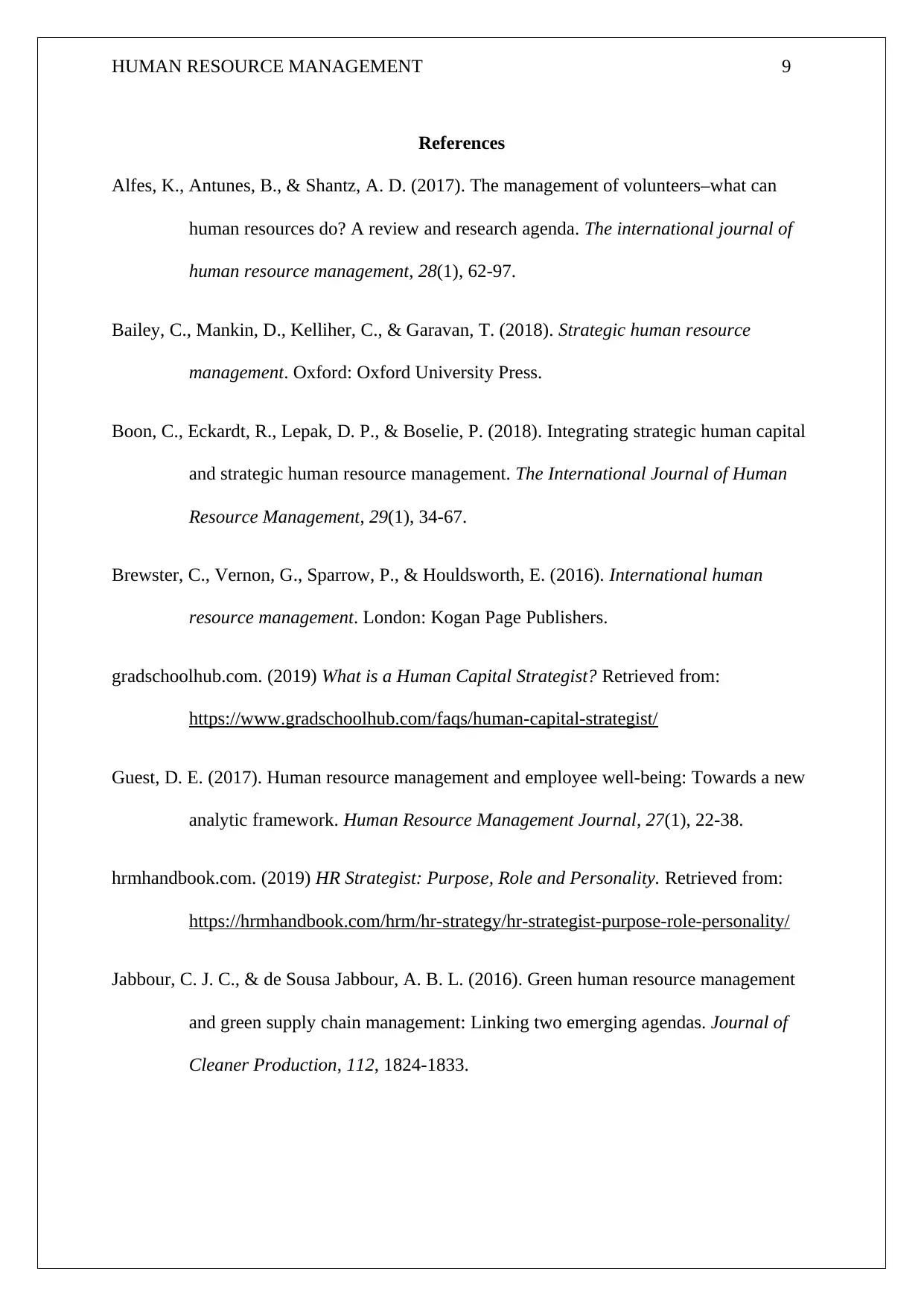
HUMAN RESOURCE MANAGEMENT 9
References
Alfes, K., Antunes, B., & Shantz, A. D. (2017). The management of volunteers–what can
human resources do? A review and research agenda. The international journal of
human resource management, 28(1), 62-97.
Bailey, C., Mankin, D., Kelliher, C., & Garavan, T. (2018). Strategic human resource
management. Oxford: Oxford University Press.
Boon, C., Eckardt, R., Lepak, D. P., & Boselie, P. (2018). Integrating strategic human capital
and strategic human resource management. The International Journal of Human
Resource Management, 29(1), 34-67.
Brewster, C., Vernon, G., Sparrow, P., & Houldsworth, E. (2016). International human
resource management. London: Kogan Page Publishers.
gradschoolhub.com. (2019) What is a Human Capital Strategist? Retrieved from:
https://www.gradschoolhub.com/faqs/human-capital-strategist/
Guest, D. E. (2017). Human resource management and employee well‐being: Towards a new
analytic framework. Human Resource Management Journal, 27(1), 22-38.
hrmhandbook.com. (2019) HR Strategist: Purpose, Role and Personality. Retrieved from:
https://hrmhandbook.com/hrm/hr-strategy/hr-strategist-purpose-role-personality/
Jabbour, C. J. C., & de Sousa Jabbour, A. B. L. (2016). Green human resource management
and green supply chain management: Linking two emerging agendas. Journal of
Cleaner Production, 112, 1824-1833.
References
Alfes, K., Antunes, B., & Shantz, A. D. (2017). The management of volunteers–what can
human resources do? A review and research agenda. The international journal of
human resource management, 28(1), 62-97.
Bailey, C., Mankin, D., Kelliher, C., & Garavan, T. (2018). Strategic human resource
management. Oxford: Oxford University Press.
Boon, C., Eckardt, R., Lepak, D. P., & Boselie, P. (2018). Integrating strategic human capital
and strategic human resource management. The International Journal of Human
Resource Management, 29(1), 34-67.
Brewster, C., Vernon, G., Sparrow, P., & Houldsworth, E. (2016). International human
resource management. London: Kogan Page Publishers.
gradschoolhub.com. (2019) What is a Human Capital Strategist? Retrieved from:
https://www.gradschoolhub.com/faqs/human-capital-strategist/
Guest, D. E. (2017). Human resource management and employee well‐being: Towards a new
analytic framework. Human Resource Management Journal, 27(1), 22-38.
hrmhandbook.com. (2019) HR Strategist: Purpose, Role and Personality. Retrieved from:
https://hrmhandbook.com/hrm/hr-strategy/hr-strategist-purpose-role-personality/
Jabbour, C. J. C., & de Sousa Jabbour, A. B. L. (2016). Green human resource management
and green supply chain management: Linking two emerging agendas. Journal of
Cleaner Production, 112, 1824-1833.
Secure Best Marks with AI Grader
Need help grading? Try our AI Grader for instant feedback on your assignments.
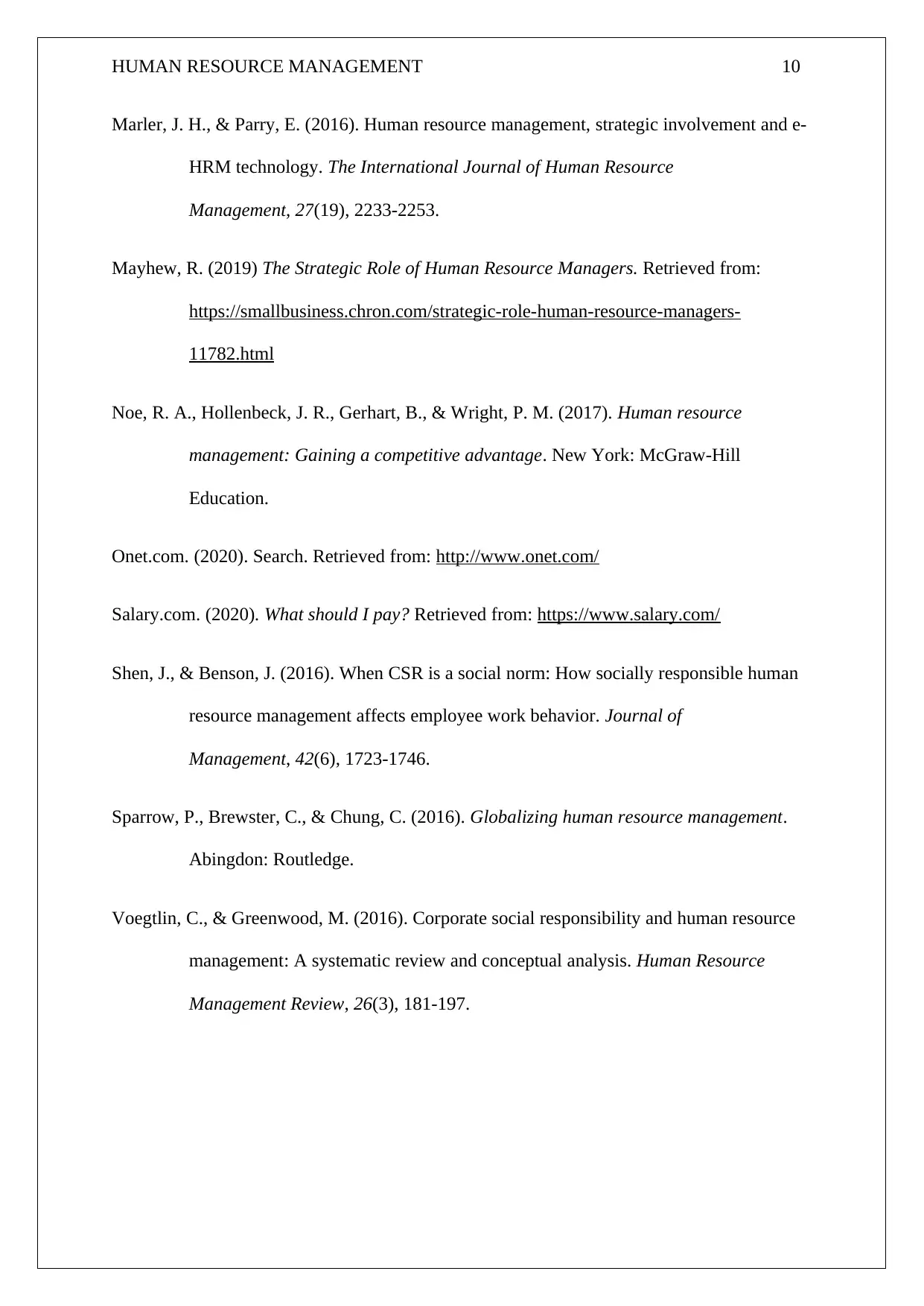
HUMAN RESOURCE MANAGEMENT 10
Marler, J. H., & Parry, E. (2016). Human resource management, strategic involvement and e-
HRM technology. The International Journal of Human Resource
Management, 27(19), 2233-2253.
Mayhew, R. (2019) The Strategic Role of Human Resource Managers. Retrieved from:
https://smallbusiness.chron.com/strategic-role-human-resource-managers-
11782.html
Noe, R. A., Hollenbeck, J. R., Gerhart, B., & Wright, P. M. (2017). Human resource
management: Gaining a competitive advantage. New York: McGraw-Hill
Education.
Onet.com. (2020). Search. Retrieved from: http://www.onet.com/
Salary.com. (2020). What should I pay? Retrieved from: https://www.salary.com/
Shen, J., & Benson, J. (2016). When CSR is a social norm: How socially responsible human
resource management affects employee work behavior. Journal of
Management, 42(6), 1723-1746.
Sparrow, P., Brewster, C., & Chung, C. (2016). Globalizing human resource management.
Abingdon: Routledge.
Voegtlin, C., & Greenwood, M. (2016). Corporate social responsibility and human resource
management: A systematic review and conceptual analysis. Human Resource
Management Review, 26(3), 181-197.
Marler, J. H., & Parry, E. (2016). Human resource management, strategic involvement and e-
HRM technology. The International Journal of Human Resource
Management, 27(19), 2233-2253.
Mayhew, R. (2019) The Strategic Role of Human Resource Managers. Retrieved from:
https://smallbusiness.chron.com/strategic-role-human-resource-managers-
11782.html
Noe, R. A., Hollenbeck, J. R., Gerhart, B., & Wright, P. M. (2017). Human resource
management: Gaining a competitive advantage. New York: McGraw-Hill
Education.
Onet.com. (2020). Search. Retrieved from: http://www.onet.com/
Salary.com. (2020). What should I pay? Retrieved from: https://www.salary.com/
Shen, J., & Benson, J. (2016). When CSR is a social norm: How socially responsible human
resource management affects employee work behavior. Journal of
Management, 42(6), 1723-1746.
Sparrow, P., Brewster, C., & Chung, C. (2016). Globalizing human resource management.
Abingdon: Routledge.
Voegtlin, C., & Greenwood, M. (2016). Corporate social responsibility and human resource
management: A systematic review and conceptual analysis. Human Resource
Management Review, 26(3), 181-197.
1 out of 11
Related Documents
Your All-in-One AI-Powered Toolkit for Academic Success.
+13062052269
info@desklib.com
Available 24*7 on WhatsApp / Email
![[object Object]](/_next/static/media/star-bottom.7253800d.svg)
Unlock your academic potential
© 2024 | Zucol Services PVT LTD | All rights reserved.





